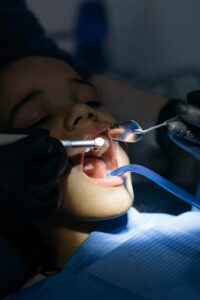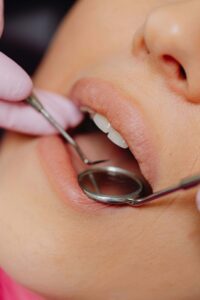Maintaining impeccable oral hygiene is crucial, especially when you have braces. Braces, while essential for correcting dental issues, can make cleaning your teeth a bit more challenging. One particular challenge is flossing.
If you’re wondering how to floss with braces effectively, you’ve come to the right place. This guide is packed with tips and tricks to help you keep your teeth and gums healthy throughout your orthodontic journey.
Let’s take a look.
Why Flossing with Braces Can Be Challenging
Flossing with braces isn’t as straightforward as it is without them. The wires and brackets create obstacles that make it difficult to reach between your teeth and gums.
Traditional floss can get caught or frayed on the metal components, leading to frustration and incomplete cleaning.
Furthermore, failing to floss properly with braces can result in plaque buildup, gum disease, and even cavities. It’s essential to understand these challenges to better appreciate the importance of proper flossing techniques.
The Right Tools for the Job
To overcome the hurdles of flossing with braces, you’ll need the right tools.
Here are some specialized flossing tools that can make the task easier and more effective:
Floss Threaders: Floss threaders resemble large, flexible plastic needles. They help guide the floss under the archwire and between the teeth, making it possible to floss each tooth individually.
Interdental Brushes: These small brushes fit between your braces and teeth, cleaning areas that traditional brushes can’t reach. They’re particularly useful for removing food particles and plaque from around the brackets.
Water Flossers: Water flossers use a stream of water to clean between your teeth and braces. They’re highly effective and easy to use, making them a favorite among orthodontic patients.
With these tools in your arsenal, flossing with braces becomes less of a hassle and more of a routine.
Guide on The Best Way to Floss with Braces
Now that you have the right tools, let’s walk through the steps for flossing with braces using each tool.
Using Floss Threaders
- Thread the Floss: Take an 18-inch piece of floss and thread it through the floss threader.
- Insert the Threader: Carefully insert the threader under the archwire and pull the floss through.
- Floss Between Teeth: Move the floss up and down between your teeth and under the gumline.
- Repeat: Remove the floss, re-thread it, and move to the next tooth.
Using Interdental Brushes
- Select the Right Size: Choose a brush size that fits comfortably between your braces and teeth.
- Insert the Brush: Gently insert the brush between your teeth and braces.
- Clean All Areas: Move the brush back and forth to remove plaque and food particles.
- Rinse and Repeat: Rinse the brush and repeat the process for each gap.
Using Water Flossers
- Fill the Reservoir: Fill the water flosser’s reservoir with lukewarm water.
- Adjust the Settings: Choose a pressure setting that’s comfortable for you.
- Direct the Stream: Aim the water stream at the gumline and between the teeth.
- Move Along: Slowly move the flosser along the gumline and around each bracket.
Tips and Tricks for Flossing with Braces
Here are a few additional tips to make flossing with braces even more effective:
- Floss after every meal: Food particles can easily get trapped in your braces, so it’s essential to floss after meals to prevent plaque buildup.
- Be gentle: Braces can be delicate, so take it easy when flossing around them. Avoid using excessive force or pulling too hard on the floss.
- Use waxed floss: Waxed floss is less likely to get caught or shred on brackets and wires compared to unwaxed floss.
- Don’t forget the back teeth: It’s easy to overlook the back teeth while flossing, but they also need just as much attention.
- Be patient: Flossing with braces may take a bit longer, but it’s worth the effort for healthy teeth and gums.
Common Mistakes to Avoid
Avoiding common mistakes can make your flossing routine more effective and less frustrating:
Skipping Days
Skipping flossing for even a single day can lead to plaque buildup and gum issues. Make flossing a non-negotiable part of your daily routine.
So make sure not to skip any days!
Using the Same Section of Floss
It can be tempting to use the same section of floss for multiple teeth, but this can result in spreading bacteria and plaque.
Use a clean section of floss for each tooth.
Neglecting the Gumline
The gumline is where plaque and food particles often accumulate, so make sure to thoroughly clean along the gums while flossing.
Conclusion
Now that you know how to floss with braces effectively, make sure to incorporate it into your daily oral hygiene routine. Along with regular brushing and dental visits, proper flossing can help you maintain a healthy smile during your orthodontic treatment.
Remember, the right tools, techniques, and consistency are crucial for keeping your teeth and gums clean and healthy while wearing braces.
Prioritize your oral hygiene, and don’t hesitate to consult with us here at My Smile Orthodontist for personalized advice and support. Schedule a consultation with Dr. Mandalia today to discuss your braces and oral hygiene needs.
Together, we’ll help you achieve the smile you’ve always dreamed of!












